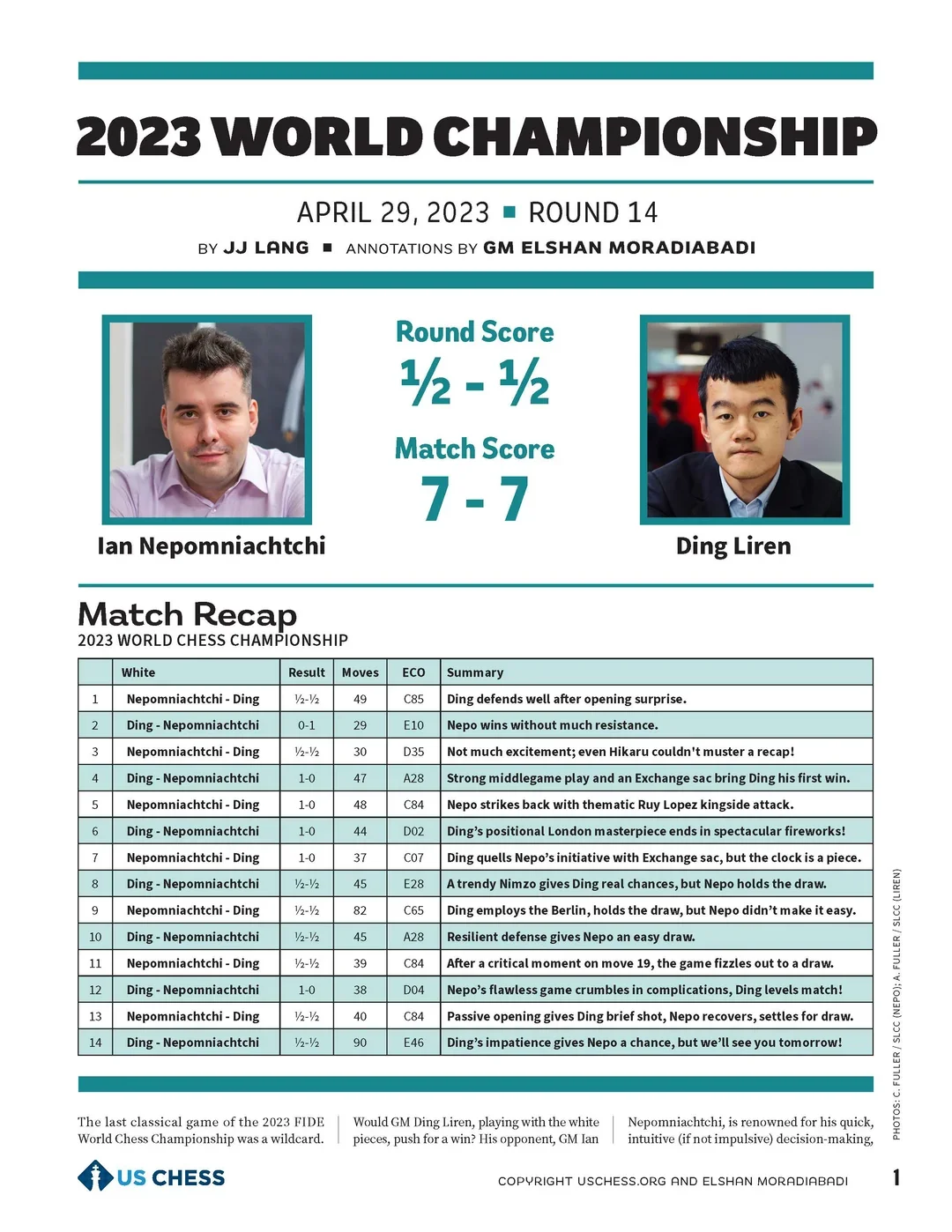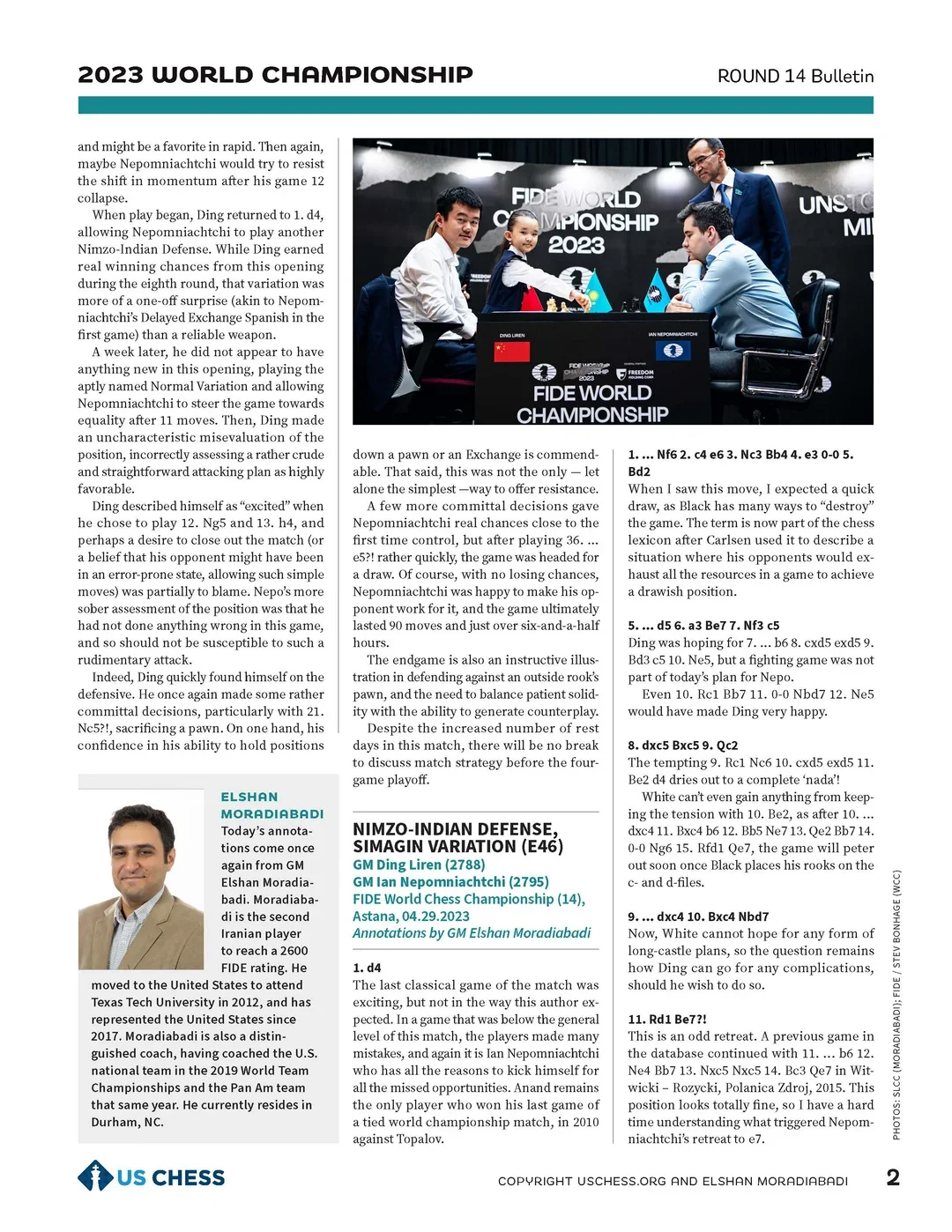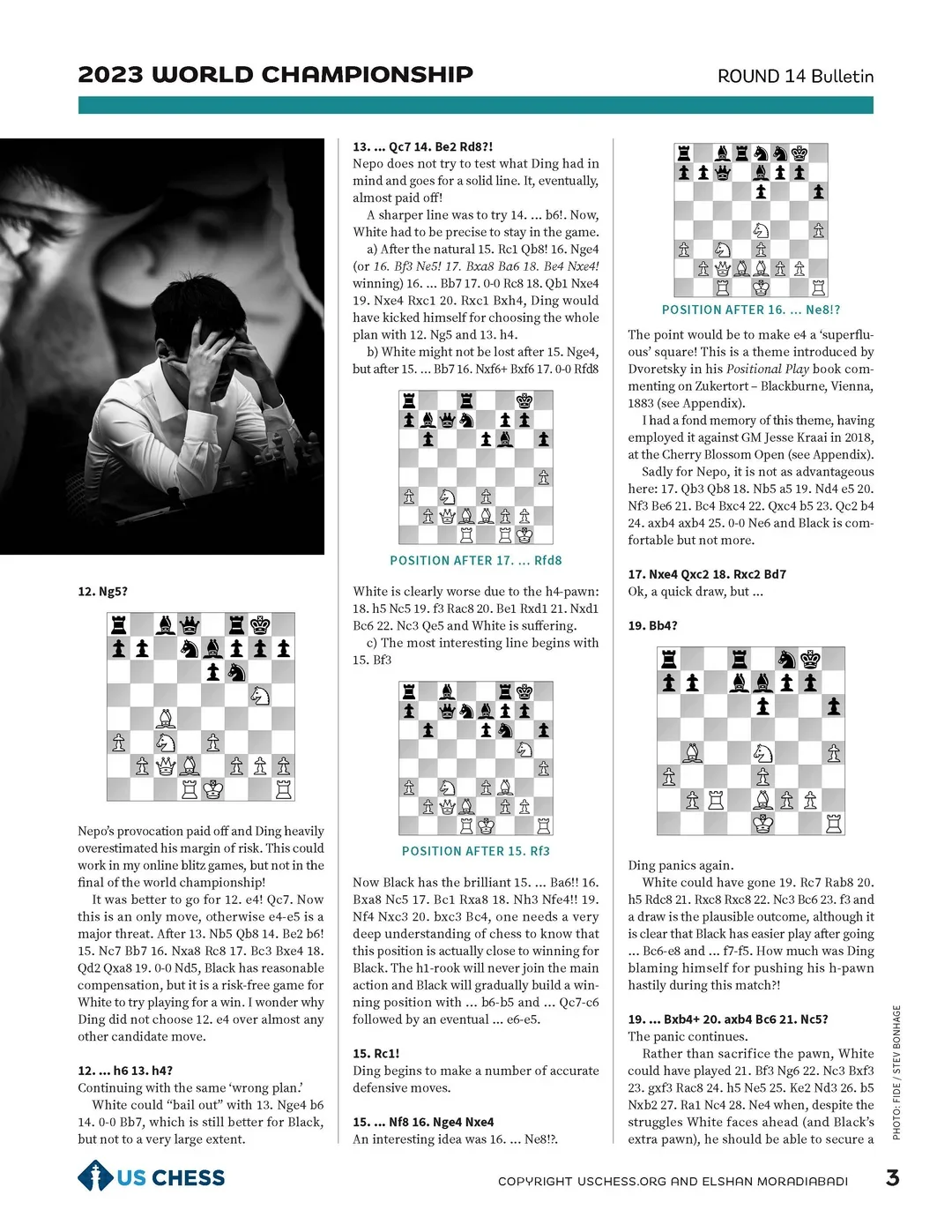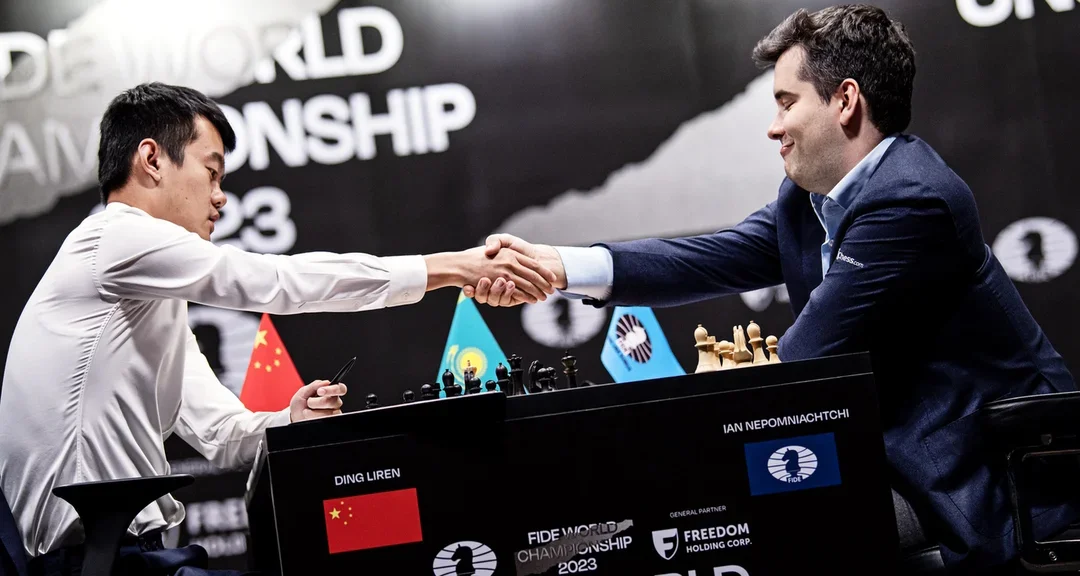
Please download our printable bulletin, or follow along now with GM Elshan Moradiabadi's annotations below.
The last classical game of the 2023 FIDE World Chess Championship was a wildcard. Would GM Ding Liren, playing with the white pieces, push for a win? His opponent, GM Ian Nepomniachtchi, is renowned for his quick, intuitive (if not impulsive) decision-making, and might be a favorite in rapid. Then again, maybe Nepomniachtchi would try to resist the shift in momentum after his game 12 collapse.
When play began, Ding returned to 1. d4, allowing Nepomniachtchi to play another Nimzo-Indian Defense. While Ding earned real winning chances from this opening during the eighth round, that variation was more of a one-off surprise (akin to Nepomniachtchi’s Delayed Exchange Spanish in the first game) than a reliable weapon.
A week later, he did not appear to have anything new in this opening, playing the aptly named Normal Variation and allowing Nepomniachtchi to steer the game towards equality after 11 moves. Then, Ding made an uncharacteristic misevaluation of the position, incorrectly assessing a rather crude and straightforward attacking plan as highly favorable.
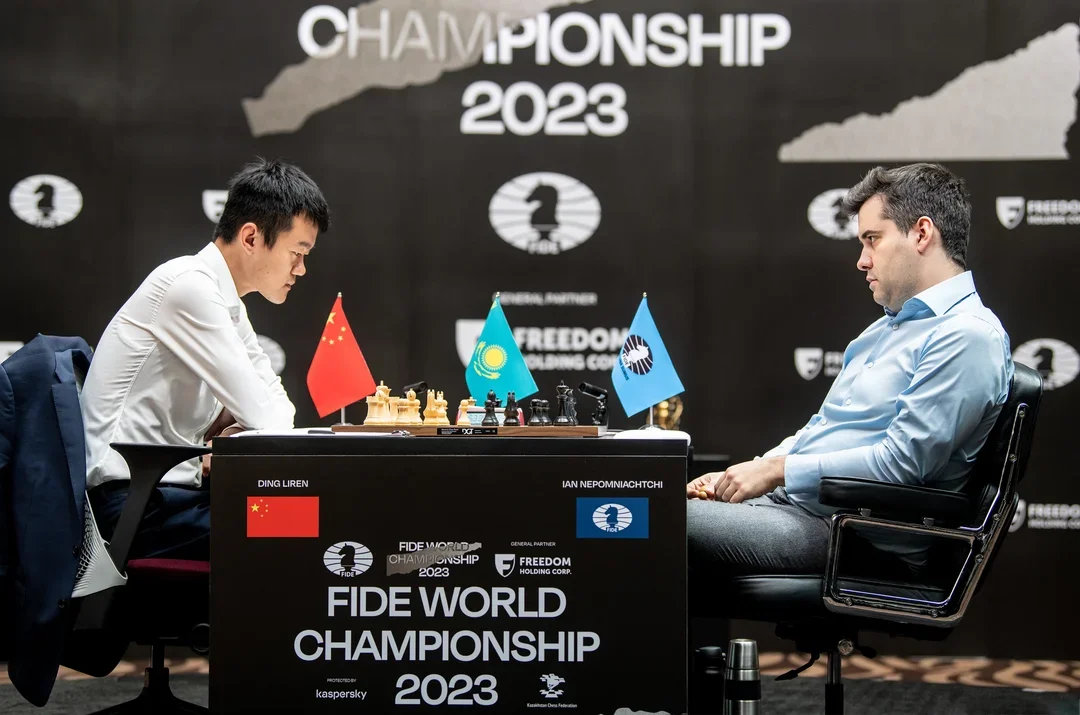
Ding described himself as “excited” when he chose to play 12. Ng5 and 13. h4, and perhaps a desire to close out the match (or a belief that his opponent might have been in an error-prone state, allowing such simple moves) was partially to blame. Nepo’s more sober assessment of the position was that he had not done anything wrong in this game, and so should not be susceptible to such a rudimentary attack.
Indeed, Ding quickly found himself on the defensive. He once again made some rather committal decisions, particularly with 21. Nc5?!, sacrificing a pawn. On one hand, his confidence in his ability to hold positions down a pawn or Exchange is commendable. That said, this was not the only — let alone the simplest —way to offer resistance.
A few more committal decisions gave Nepomniachtchi real chances close to the first time control, but after playing 36. … e5?! rather quickly, the game was headed for a draw. Of course, with no losing chances, Nepomniachtchi was happy to make his opponent work for it, and the game ultimately lasted 90 moves and just over six-and-a-half hours.
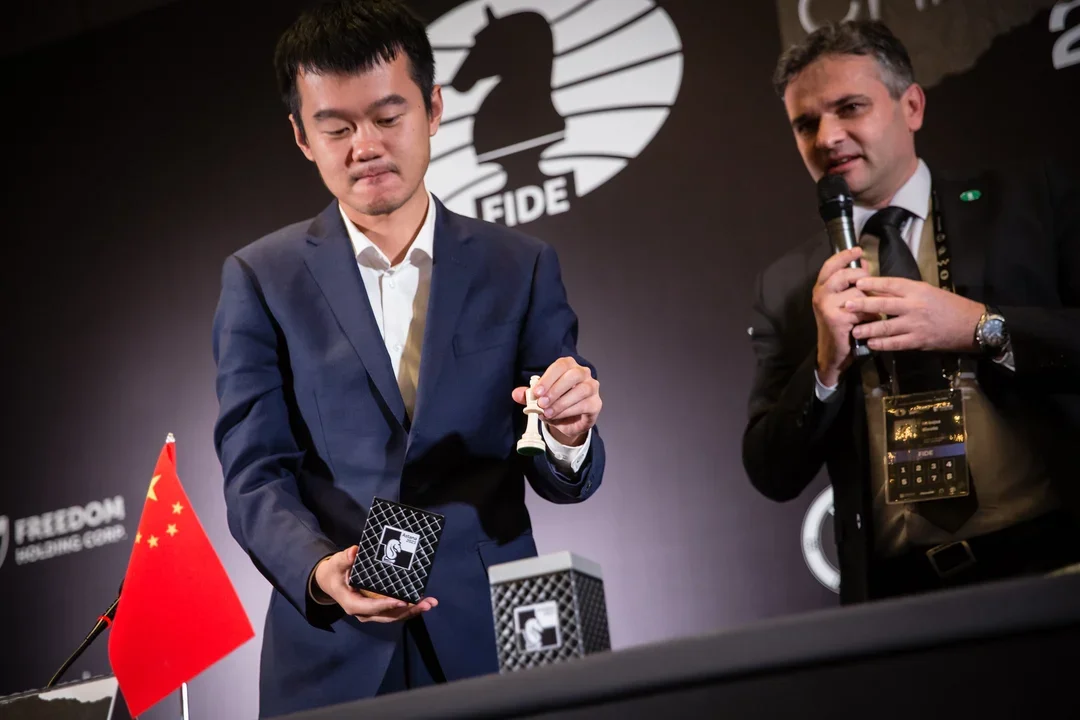
The endgame is also an instructive illustration in defending against an outside rook’s pawn, and the need to balance patient solidity with the ability to generate counterplay.
Despite the increased number of rest days in this match, there will be no break to discuss match strategy before the four-game playoff.
Today’s annotations come once again from GM Elshan Moradiabadi. Moradiabadi is the second Iranian player to reach a 2600 FIDE rating. He moved to the United States to attend Texas Tech University in 2012, and has represented the United States since 2017. Moradiabadi is also a distinguished coach, having coached the U.S. national team in the 2019 World Team Championships and the Pan Am team that same year. He currently resides in Durham, NC.
See all of our 2023 FIDE World Championship coverage.
See results and full schedule on the official website.
Follow our lichess profile for more studies.
Watch live commentary of each round on Chess.com and from FIDE.
Categories
Archives
- January 2026 (1)
- December 2025 (27)
- November 2025 (29)
- October 2025 (39)
- September 2025 (27)
- August 2025 (29)
- July 2025 (43)
- June 2025 (25)
- May 2025 (24)
- April 2025 (29)
- March 2025 (29)
- February 2025 (20)
- January 2025 (24)
- December 2024 (34)
- November 2024 (18)
- October 2024 (35)
- September 2024 (23)
- August 2024 (27)
- July 2024 (44)
- June 2024 (27)
- May 2024 (31)
- April 2024 (51)
- March 2024 (34)
- February 2024 (25)
- January 2024 (26)
- December 2023 (29)
- November 2023 (26)
- October 2023 (37)
- September 2023 (27)
- August 2023 (37)
- July 2023 (47)
- June 2023 (33)
- May 2023 (37)
- April 2023 (45)
- March 2023 (37)
- February 2023 (28)
- January 2023 (31)
- December 2022 (23)
- November 2022 (32)
- October 2022 (31)
- September 2022 (19)
- August 2022 (39)
- July 2022 (32)
- June 2022 (35)
- May 2022 (21)
- April 2022 (31)
- March 2022 (33)
- February 2022 (21)
- January 2022 (27)
- December 2021 (36)
- November 2021 (34)
- October 2021 (25)
- September 2021 (25)
- August 2021 (41)
- July 2021 (36)
- June 2021 (29)
- May 2021 (29)
- April 2021 (31)
- March 2021 (33)
- February 2021 (28)
- January 2021 (29)
- December 2020 (38)
- November 2020 (40)
- October 2020 (41)
- September 2020 (35)
- August 2020 (38)
- July 2020 (36)
- June 2020 (46)
- May 2020 (42)
- April 2020 (37)
- March 2020 (60)
- February 2020 (38)
- January 2020 (45)
- December 2019 (34)
- November 2019 (35)
- October 2019 (42)
- September 2019 (45)
- August 2019 (56)
- July 2019 (44)
- June 2019 (35)
- May 2019 (40)
- April 2019 (48)
- March 2019 (61)
- February 2019 (39)
- January 2019 (30)
- December 2018 (29)
- November 2018 (51)
- October 2018 (45)
- September 2018 (29)
- August 2018 (49)
- July 2018 (35)
- June 2018 (31)
- May 2018 (39)
- April 2018 (31)
- March 2018 (26)
- February 2018 (33)
- January 2018 (30)
- December 2017 (26)
- November 2017 (24)
- October 2017 (30)
- September 2017 (30)
- August 2017 (31)
- July 2017 (28)
- June 2017 (32)
- May 2017 (26)
- April 2017 (37)
- March 2017 (28)
- February 2017 (30)
- January 2017 (27)
- December 2016 (29)
- November 2016 (24)
- October 2016 (32)
- September 2016 (31)
- August 2016 (27)
- July 2016 (24)
- June 2016 (26)
- May 2016 (19)
- April 2016 (30)
- March 2016 (36)
- February 2016 (28)
- January 2016 (32)
- December 2015 (26)
- November 2015 (23)
- October 2015 (16)
- September 2015 (28)
- August 2015 (28)
- July 2015 (6)
- June 2015 (1)
- May 2015 (2)
- April 2015 (1)
- February 2015 (3)
- January 2015 (1)
- December 2014 (1)
- July 2010 (1)
- October 1991 (1)
- August 1989 (1)
- January 1988 (1)
- December 1983 (1)


